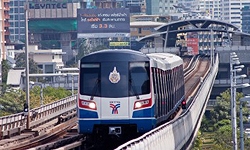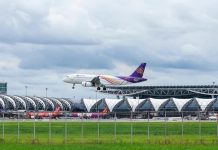Getting around Bangkok
With a growing mass transit system and ongoing highway expansion, it’s easier than ever to get around Bangkok. However, the city’s well-known traffic jams still occur during peak travel times, on weekends and during rainy season.
Visitors to Bangkok have many public transportation options available. Many tourists chose to travel by the BTS elevated rail system, which has two lines serving central Bangkok and recently expanded into the suburbs. There is also a subway line operated called the MRT that forms a partial loop around the city. The MRT system is currently undergoing a major expansion program. Both of these rail systems are well marked with maps and signage in both Thai and English, making it quick and easy to get around.

Taxis are widely available in Bangkok, although you may have to wait during peak hours or when it is raining. Almost all taxis are air conditioned and are equipped with meters. Taxis are widely used by visitors to Thailand. While some taxi drivers speak English well, many have limited foreign language ability. It’s helpful to have the name of your destination, as well as your accommodation, written in Thai. Taxis that are available for hire display a red light on the left side of the windshield.
The Bangkok Mass Transit Authority (BMTA) has a vast network of bus routes that reach every part of the city. It operates several types of vehicles ranging from air-conditioned, articulated coaches to older, non-air conditioned buses. The BMTA also uses contractors to operate on some routes. While many buses have some English-language signage, bus drivers and conductors have limited English ability. Visitors to Thailand will find bus fares to be very low, but can also find it challenging to make their way around the city if not already familiar with the various bus routes.
Bangkok streets are also teeming with three-wheeled tuk-tuks. Many visitors consider a tuk-tuk ride as an essential part of their Thailand experience. As tuk-tuks have no meter, you need to negotiate with the fare with the driver before you get in. Reports of serious crimes involving taxis or tuk-tuks are rare, although attempts to charge excessive fares occur regularly.
“Songtaews,” which are small, red trucks with bench seats in the back, generally serve areas outside of central Bangkok. Fares are determined by the driver, and this mode of transport is rarely used by tourists.
Motorcycle taxis are also available on many street corners, serving areas where public transit does not go. Although helmets are mandatory under Thai traffic laws, they are not always available for passengers. There are also risks of accidents when riding a motorcycle taxi through Bangkok’s busy streets.
Several passenger boat services travel the Chao Phraya River as well as some of the city’s major canals. They are an interesting way for tourists to get an interesting perspective on the city.
Most major hotels have a fleet of automobiles with drivers that you can charter for transportation to and from the airport, as well as for travelling in Bangkok and the surrounding areas.
Public transportation in places outside of Bangkok
Most locations outside of Bangkok do not have a public transit system, and metered taxis are only found in a few places. Local transport is provided in the form of pickup trucks with covered benches in the back, samlors, motorcycle taxis, and even bicycle rickshaws. For all of these services, you should determine a price with the driver before departing. Most places where tourists stay can help to arrange for or provide advice on the best way to get around.
Safety on Public Transportation
Mass transit systems:
Both the BTS elevated system and the MTR subway system are clean, modern and safe.
The only precautions you need to take are the same as you would on mass transit systems in other major cities worldwide – be aware of your surroundings and watch your personal belongings, especially when travelling during peak times.
Taxis:
Only take registered taxis, which are clearly identified with official markings and have black-on-yellow number plates. Beware of unmarked taxis with black-on-white number plates, which are not registered.
Have both the name of your destination and the place you are staying written in Thai if possible to help ensure you end up at your desired destination.
Some taxi drivers may advise you that the destination to which you are going is not open or accessible, and may suggest alternate destinations. You should be firm with such drivers that you want to go to your original destination.
You may encounter taxi drivers and others who tout gem stores or entertainment venues. These touts receive kickbacks or commissions for bringing you to these places. Travellers should not accept tours or other offers from them.
Do not hesitate to ask to be let out of a taxi immediately if the driver is acting suspiciously or driving erratically.
Tuk-tuks:
As these vehicles have no meters, make sure you clearly establish the fare with the driver before departing to avoid disputes when you arrive at your destination.
Tuk-tuks are open vehicles – be sure to keep your arms and legs within the passenger compartment, especially in heavy traffic.
Keep hold of items such as backpacks and purses to avoid losing them.
The same advice as with taxis applies in terms of having your destination and hotel written down and being firm about having the driver take you where you actually want to go.
Passenger boats:
These boats can become crowded during peak times. Try to ride them after the morning rush hour or before the evening rush hour to have a more relaxed journey.
Many boat services stop at floating docks and jetties. Be ready for these platforms to shift due to waves or as passengers move around on them.
Some of the stops these boats make are very brief. Be prepared in advance to get off at your desired destination.
Buses:
The speed at which BMTA buses travel can vary greatly due to Bangkok’s constantly changing traffic conditions. Make sure you hold on to the handrails and be prepared for sudden stops.
Some of the stops these boat buses make are very brief. Be prepared in advance to get off at your desired destination.




